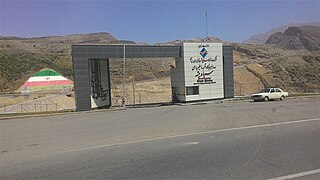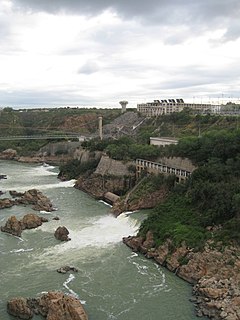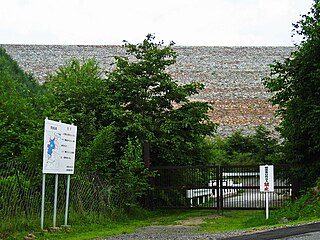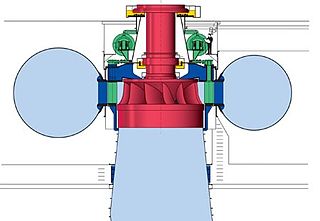
The Siah Bisheh Pumped Storage Power Plant, also spelled Siyāhbisheh and Siah Bishe, is located in the Alborz Mountain range near the village of Siah Bisheh and 48 km (30 mi) south of Chalus in Mazandaran Province, Iran. The power plant uses the pumped-storage hydroelectric method to generate electricity during periods of high energy demand, making it a peaking power plant, intended to fulfill peak electricity demand in Tehran 60 km (37 mi) to the south. When complete it will have an installed generating capacity of 1,040 megawatts (1,390,000 hp) and a pumping capacity of 940 megawatts (1,260,000 hp). Planning for the project began in the 1970s and construction began in 1985. It was delayed from 1992 until 2001 and the first generator went online in May 2013. The remaining generators were commissioned by 1 September 2015. The power plant is the first pumped-storage type in Iran and will also use the country's first concrete-face rock-fill dam – two of them.

The Kannagawa Hydropower Plant (神流川発電所) is an under construction pumped-storage hydroelectric power plant near Minamiaiki in Nagano Prefecture and Ueno in Gunma Prefecture, Japan. The power plant utilizes the Minamiaiki River along with an upper and lower reservoir created by two dams, the upper Minamiaiki Dam and the lower Ueno Dam. The power station in between the two dams will contain six 470 megawatts (630,000 hp) pump-generators for a total installed capacity of 2,820 megawatts (3,780,000 hp). Unit 1 commenced commercial operation in 2005 and Unit 2 in 2012. When completed, the plant will have the second-largest pumped-storage power capacity in the world.

Irganai Dam is a hydroelectric dam in the Untskul region of Dagestan, Russia. It is located on the river Avar Koisu.

The Paulo Afonso Hydroelectric Complex, also known as the Paulo Afonso Complex, is a system of three dams and five hydroelectric power plants on the São Francisco River near the city of Paulo Afonso in Bahia, Brazil. The complex exploits an 80-metre (260 ft) natural gap on the river, known as the Paulo Afonso Falls. Constructed in succession between 1948 and 1979, the dams support the Paulo Afonso I, II, III, IV and Apollonius Sales (Moxotó) power plants which contain a total of 23 generators with an installed capacity of 4,279.6 megawatts (5,739,000 hp).

The Governor José Richa Hydroelectric Plant, formerly known as Salto Caxias, is a dam and hydroelectric power plant on the Iguazu River near Caxias in Paraná, Brazil. It is the first dam upstream of the Iguazu Falls and was constructed between 1995 and 1999. The power station has a 1,240-megawatt (1,660,000 hp) capacity and is supplied with water by a roller-compacted concrete gravity dam.

The Governor Bento Munhoz da Rocha Netto Hydroelectric Plant, formerly known as Foz do Areia, is dam and hydroelectric power plant on the Iguazu River near Foz do Areia in Paraná, Brazil. It is the furthest dam upstream of the Iguazu Falls and was constructed between 1976 and 1980. The power station has a 1,676 megawatts (2,248,000 hp) capacity and is supplied with water by a concrete face rock-fill embankment dam.

The Serra da Mesa Dam, once known as Sao Felix, is an embankment dam on the Tocantins River near Minaçu in Goiás, Brazil. The dam serves an associated hydroelectric power plant with a 1,275 megawatts (1,710,000 hp) installed capacity. The dam creates the largest reservoir by volume in Brazil.

The Marimbondo Dam is an embankment dam on the Grande River near Fronteira in Minas Gerais, Brazil. The dam serves an associated hydroelectric power plant with a 1,440 megawatts (1,930,000 hp) installed capacity.

The Engineer Souza Dias Dam, formerly known as the Jupiá Dam is an embankment dam on the Paraná River near Três Lagoas in Mato Grosso do Sul, Brazil. It was constructed for hydroelectric power production, flood control and navigation. Studies on the dam and power plant began in 1951 which recommended the dam along with the Ilha Solteira Dam. The dam was inaugurated in 1968 and its generators were commissioned between 1969 and 1974.

The Água Vermelha Dam is an embankment dam on the Grande River near Iturama in Minas Gerais/São Paulo, Brazil. It was constructed for hydroelectric power production and flood control. Construction on the dam began in 1973 and it was completed and operational by 1978. The last generators were operational in 1979.

La Esmeralda Dam is an embankment dam on the Batá River northwest of Santa María in Boyacá Department, Neira Province, Colombia. The primary purpose of the dam is hydroelectric power production and it is part of the Chivor Hydroelectric Project. Water from the Batá is diverted by the dam to a power station that discharges to the Lengupá River. The power station supplies 8% of Colombia's power demand.

The Punchiná Dam is an embankment dam on the Guatapé River 17 kilometres (11 mi) east of San Carlos in Antioquia Department, Colombia. The dam creates Punchiná Reservoir which is part of the 1,240 megawatts (1,660,000 hp) San Carlos Hydroelectric Power Plant. The power plant was completed in two 620 megawatts (830,000 hp) stages, the first was completed in 1984 and the second in 1987. It is the largest power station in Colombia.

The Porce III Dam is an embankment dam on the Porce River 90 kilometres (56 mi) northeast of Medellín in Antioquia Department, Colombia. The dam was constructed between 2004 and 2011 for the primary purpose of hydroelectric power generation.

The Shin-Takasegawa Pumped Storage Station (新高瀬川発電所) uses the Takase River to operate a pumped storage hydroelectric scheme about 12 kilometres (7.5 mi) west of Ōmachi in Nagano Prefecture, Japan. Part of the system is within Chūbu-Sangaku National Park.

The Kazunogawa Pumped Storage Power Station is a pumped-storage hydroelectric power station near Kōshū in Yamanashi Prefecture, Japan. The station is designed to have an installed capacity of 1,600 megawatts (2,100,000 hp) and three of the four 400 megawatts (540,000 hp) generators are currently operational, for a total operational capacity of 1200 MW. Construction on the power station began in 1993 and the first generator was commissioned on 3 December 1999. The second was commissioned on 8 June 2000. The third on become operational on 9 June 2014, six year early due to post-power demand from the Great East Japan earthquake. The fourth and final generator is slate to be commissioned by 2024. It is owned by TEPCO and was constructed at a cost of $2.2 billion USD.

The Vianden Pumped Storage Plant is located just north of Vianden in Diekirch District, Luxembourg. The power plant uses the pumped-storage hydroelectric method to generate electricity and serves as a peaking power plant. Its lower reservoir is located on the Our River, bordering Germany, and the upper is elevated above on the nearby Saint Nicholas Mountain. Construction on the plant began in 1959 and the first pump-generators were commissioned in 1962. A tenth pump-generator was installed in 1976 bringing the plant's installed generating capacity to 1,096 megawatts (1,470,000 hp). The plant generates an average of 1,650 gigawatt-hours (5,900 TJ) annually but of course consumes even more. Generally the efficiency of this energy storage method is around 70-80%. The plant is owned by Société Electrique de l'Our and RWE. Construction on an eleventh pump-generator began in 2010 and it is expected to be commissioned in 2013, which will bring the plant's installed capacity to 1,296 megawatts (1,738,000 hp).

The Sogamoso Dam is a concrete-face rock-fill dam on the Sogamoso River in northern Colombia. It is located 30 kilometres (19 mi) west of Bucaramanga in Santander Department and 285 kilometres (177 mi) north of Bogotá. The primary purpose of the dam is hydroelectric power generation and its power plant has an installed capacity of 820 megawatts (1,100,000 hp) which increased Colombia's generating capacity by 10 percent. Construction on the dam began in February 2009 and its first 273 MW Francis turbine-generator was commissioned on 1 December 2014. The other two generators were operational by 20 December 2014. The US$1.74 billion dam and power plant is owned by ISAGEN. INGETEC designed the dam in the 1990s and Impreglio was awarded the contract for construction.

Irapé Dam, the tallest dam in Brazil, is an embankment dam on the Jequitinhonha River in the state of Minas Gerais. It is on the border of Berilo and Grão Mogol districts, about 26 kilometres (16 mi) west of Virgem da Lapa. The dam was constructed between 2002 and 2006 for the purpose of hydroelectric power generation.

Murray Two Dam or Murray 2 Dam is a major ungated concrete arch dam with a controlled spillway across Khancoban Bank, a diverted flow of the Snowy and Geehi rivers in the Snowy Mountains region of New South Wales, Australia. The dam's main purpose is for the generation of hydro-power and is one of the sixteen major dams that comprise the Snowy Mountains Scheme, a vast hydroelectricity and irrigation complex constructed in south-east Australia between 1949 and 1974 and now run by Snowy Hydro.

The Vorotan Cascade, or the ContourGlobal™ Hydro Cascade, is a cascade on the Vorotan River in Syunik Province, Armenia. It was built to produce hydroelectric power and provide irrigation water. The Vorotan Cascade consists of three hydroelectric power plants and five reservoirs with a combined installed capacity of 404.2 MW. It is one of the main power generation complexes in Armenia.























